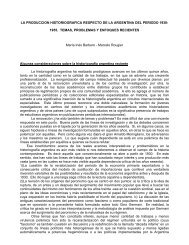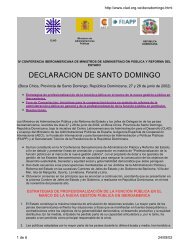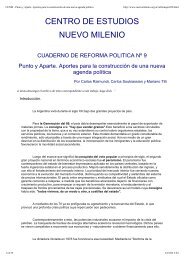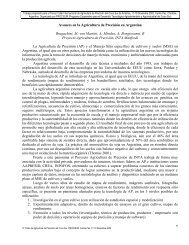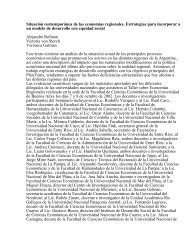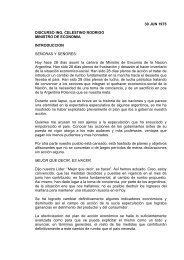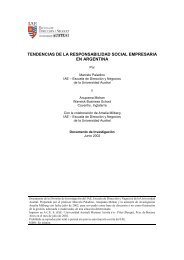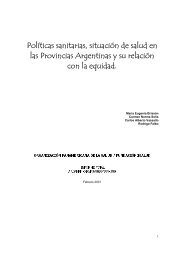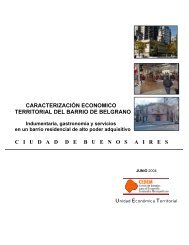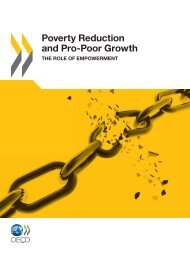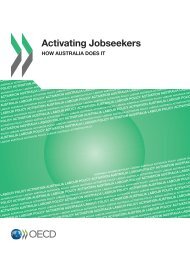Jose Hueb book 11.1
Jose Hueb book 11.1
Jose Hueb book 11.1
You also want an ePaper? Increase the reach of your titles
YUMPU automatically turns print PDFs into web optimized ePapers that Google loves.
Data analysis<br />
Electronic country files were prepared presenting all of the information<br />
collected from the global assessment questionnaire and existing survey<br />
data. The definitions of access to improved water supply and sanitation<br />
were consolidated across the two types of information source.<br />
For each country, coverage estimates from surveys were plotted<br />
against the year in which the corresponding survey had been carried out.<br />
Four separate charts were used to show coverage by year in the period<br />
1980–2000, one each for urban water, rural water, urban sanitation and<br />
rural sanitation. All other sources of data were also plotted in these charts<br />
for comparison and context, but were labelled differently. Some surveys<br />
were part of this latter category because the classification of sources or<br />
facilities was insufficient. Unfortunately, some surveys did not provide all<br />
of the information needed, not having been designed specifically to collect<br />
information about water and sanitation. For example, in many cases<br />
wells are reported without any indication of whether or how they are protected.<br />
The situation is often similar for springs.<br />
For charts where coverage estimates from surveys were considered<br />
Islamic State of Afghanistan<br />
People’s Democratic Republic of Algeria<br />
Argentine Republic<br />
People’s Republic of Bangladesh<br />
Federative Republic of Brazil<br />
People’s Republic of China<br />
Republic of Colombia<br />
Democratic People’s Republic of Korea<br />
Democratic Republic of the Congo<br />
Arab Republic of Egypt<br />
Federal Democratic Republic of Ethiopia<br />
Republic of Ghana<br />
Republic of India<br />
Republic of Indonesia<br />
Islamic Republic of Iran<br />
Republic of Iraq<br />
Republic of Kenya<br />
Republic of Madagascar<br />
Malaysia<br />
United Mexican States<br />
Methods for developing regional coverage figures<br />
Estimates of percentage coverage for a region are based upon available<br />
data from the reporting countries in the region. When no data were available<br />
for countries in a region, estimates were extrapolated from countries<br />
in the region for which data were available. Such extrapolation, however,<br />
is used only to compute regional statistics: any country data reported in<br />
this assessment are based on reports for the country concerned.<br />
adequate, a line was drawn on each chart that, in the opinion of the<br />
review group, best fitted the survey estimates over the period 1990–2000.<br />
If the estimate from this best-fit line differed substantially from the 2000<br />
estimate provided by the country, the country was asked to review its<br />
estimate in the context of the data displayed on the chart. The resulting<br />
discussions sometimes led to modification of the chart, sometimes to<br />
changes of the national estimate. Where no resolution could be obtained,<br />
the 2000 estimate derived from the survey data was used.<br />
In a small number of charts there were insufficient survey data to<br />
derive a 1990 estimate. In these cases, an estimate for 2000 only was used.<br />
For countries where there were inadequate survey data, the national<br />
estimate for 2000 provided by the country was used.<br />
Particular care was taken with the larger developing countries, as the<br />
conditions in those countries have a disproportionate effect on the global<br />
and regional averages. In particular, the 40 most populous developing<br />
countries – which account for some 90% of the population of the<br />
developing world – were the subject of special attention. These forty<br />
countries are:<br />
Kingdom of Morocco<br />
Republic of Mozambique<br />
Union of Myanmar<br />
Kingdom of Nepal<br />
Federal Republic of Nigeria<br />
Islamic Republic of Pakistan<br />
Republic of Peru<br />
Republic of the Philippines<br />
Republic of Korea<br />
Kingdom of Saudi Arabia<br />
Republic of South Africa<br />
Democratic Socialist Republic of Sri Lanka<br />
Republic of the Sudan<br />
Kingdom of Thailand<br />
Republic of Turkey<br />
Republic of Uganda<br />
United Republic of Tanzania<br />
Bolivarian Republic of Venezuela<br />
Socialist Republic of Viet Nam<br />
Republic of Yemen<br />
In summary, while the type of water source and the type of excreta<br />
disposal facility can be associated with the quality of water and the<br />
adequacy of disposal, respectively, they cannot adequately measure<br />
population coverage of safe water or of sanitary excreta disposal. Hence,<br />
the coverage estimates presented in this report represent the population<br />
covered by improved water sources and improved sanitary facilities.<br />
Global Water Supply and Sanitation Assessment 2000 Report 79



